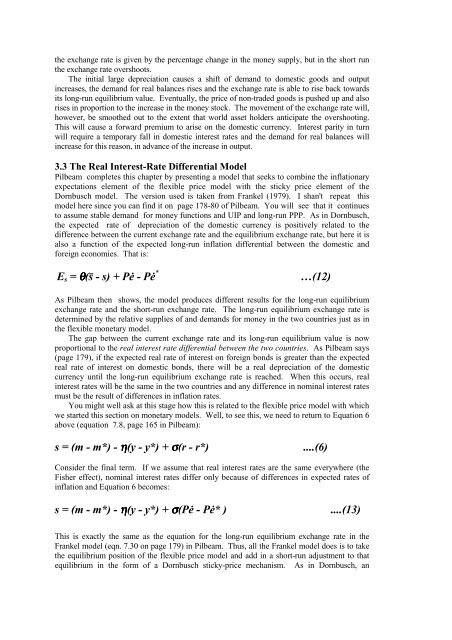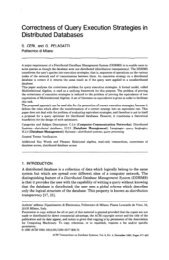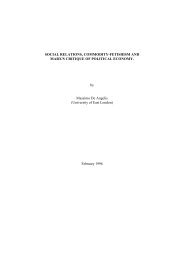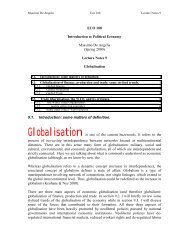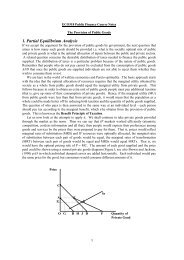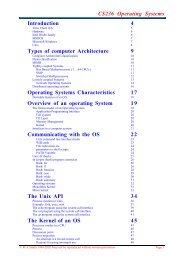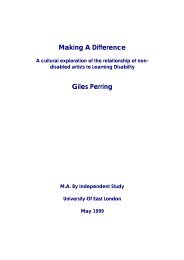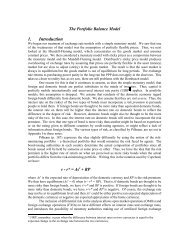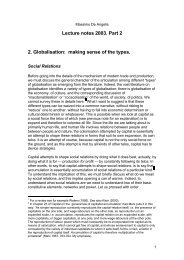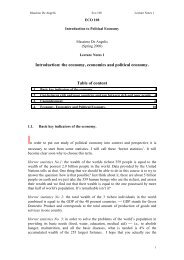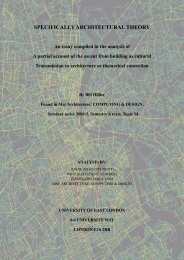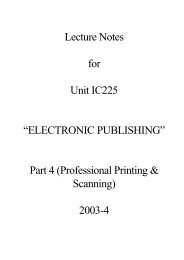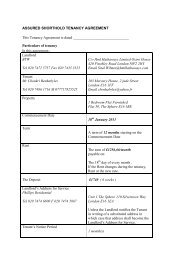1. Introduction 2. Flow models of exchange rate determination
1. Introduction 2. Flow models of exchange rate determination
1. Introduction 2. Flow models of exchange rate determination
You also want an ePaper? Increase the reach of your titles
YUMPU automatically turns print PDFs into web optimized ePapers that Google loves.
the <strong>exchange</strong> <strong>rate</strong> is given by the percentage change in the money supply, but in the short run<br />
the <strong>exchange</strong> <strong>rate</strong> overshoots.<br />
The initial large depreciation causes a shift <strong>of</strong> demand to domestic goods and output<br />
increases, the demand for real balances rises and the <strong>exchange</strong> <strong>rate</strong> is able to rise back towards<br />
its long-run equilibrium value. Eventually, the price <strong>of</strong> non-traded goods is pushed up and also<br />
rises in proportion to the increase in the money stock. The movement <strong>of</strong> the <strong>exchange</strong> <strong>rate</strong> will,<br />
however, be smoothed out to the extent that world asset holders anticipate the overshooting.<br />
This will cause a forward premium to arise on the domestic currency. Interest parity in turn<br />
will require a temporary fall in domestic interest <strong>rate</strong>s and the demand for real balances will<br />
increase for this reason, in advance <strong>of</strong> the increase in output.<br />
3.3 The Real Interest-Rate Differential Model<br />
Pilbeam completes this chapter by presenting a model that seeks to combine the inflationary<br />
expectations element <strong>of</strong> the flexible price model with the sticky price element <strong>of</strong> the<br />
Dornbusch model. The version used is taken from Frankel (1979). I shan't repeat this<br />
model here since you can find it on page 178-80 <strong>of</strong> Pilbeam. You will see that it continues<br />
to assume stable demand for money functions and UIP and long-run PPP. As in Dornbusch,<br />
the expected <strong>rate</strong> <strong>of</strong> depreciation <strong>of</strong> the domestic currency is positively related to the<br />
difference between the current <strong>exchange</strong> <strong>rate</strong> and the equilibrium <strong>exchange</strong> <strong>rate</strong>, but here it is<br />
also a function <strong>of</strong> the expected long-run inflation differential between the domestic and<br />
foreign economies. That is:<br />
Es = θθθθ(! - s) + P" - P" * …(12)<br />
As Pilbeam then shows, the model produces different results for the long-run equilibrium<br />
<strong>exchange</strong> <strong>rate</strong> and the short-run <strong>exchange</strong> <strong>rate</strong>. The long-run equilibrium <strong>exchange</strong> <strong>rate</strong> is<br />
determined by the relative supplies <strong>of</strong> and demands for money in the two countries just as in<br />
the flexible monetary model.<br />
The gap between the current <strong>exchange</strong> <strong>rate</strong> and its long-run equilibrium value is now<br />
proportional to the real interest <strong>rate</strong> differential between the two countries. As Pilbeam says<br />
(page 179), if the expected real <strong>rate</strong> <strong>of</strong> interest on foreign bonds is greater than the expected<br />
real <strong>rate</strong> <strong>of</strong> interest on domestic bonds, there will be a real depreciation <strong>of</strong> the domestic<br />
currency until the long-run equilibrium <strong>exchange</strong> <strong>rate</strong> is reached. When this occurs, real<br />
interest <strong>rate</strong>s will be the same in the two countries and any difference in nominal interest <strong>rate</strong>s<br />
must be the result <strong>of</strong> differences in inflation <strong>rate</strong>s.<br />
You might well ask at this stage how this is related to the flexible price model with which<br />
we started this section on monetary <strong>models</strong>. Well, to see this, we need to return to Equation 6<br />
above (equation 7.8, page 165 in Pilbeam):<br />
s = (m - m*) - ηηηη(y - y*) + σσσσ(r - r*) ....(6)<br />
Consider the final term. If we assume that real interest <strong>rate</strong>s are the same everywhere (the<br />
Fisher effect), nominal interest <strong>rate</strong>s differ only because <strong>of</strong> differences in expected <strong>rate</strong>s <strong>of</strong><br />
inflation and Equation 6 becomes:<br />
s = (m - m*) - ηηηη(y - y*) + σσσσ(P" - P"* ) ....(13)<br />
This is exactly the same as the equation for the long-run equilibrium <strong>exchange</strong> <strong>rate</strong> in the<br />
Frankel model (eqn. 7.30 on page 179) in Pilbeam. Thus, all the Frankel model does is to take<br />
the equilibrium position <strong>of</strong> the flexible price model and add in a short-run adjustment to that<br />
equilibrium in the form <strong>of</strong> a Dornbusch sticky-price mechanism. As in Dornbusch, an


